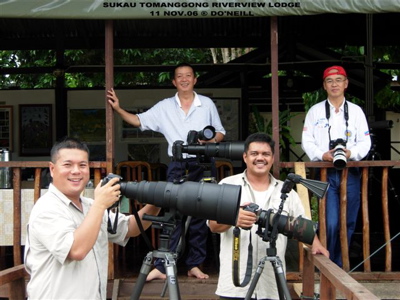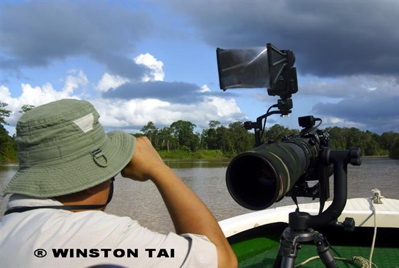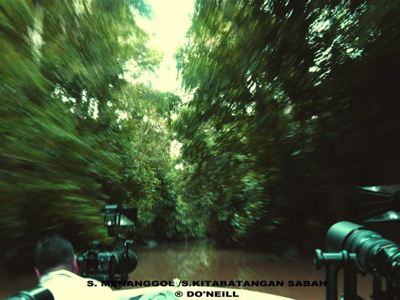North Borneo’s best kept avian passage: Part 1
 Having left a 45km stretch of paved highway and Sandakan airport distant from our minds, our bellies reminded us that dinner was in wanting.
Having left a 45km stretch of paved highway and Sandakan airport distant from our minds, our bellies reminded us that dinner was in wanting.The aroma of barbequed meat sent our driver to halt the 4-WD in a village town, where last minute sundry supplies could be had at the local supermarket. Delicious 5-piece chicken-looking fillets, char-broiled and skewed in satay sticks took our fancy and Chien, my birding pal, made no hesitation to order seven sticks. It did not take long to figure out that after having swallowed a couple of mouthfuls, we were swallowing buntits - Sabahans’ local delicacy. ‘Bishop Noses’ the farangs (red haired devils) would have called them.
The journey continued with me narrating a story about a tourist visiting a Chinese restaurant in Hong Kong, intrigued with the menu and ordered ‘pigeon tongues’. The plate arrived with the equivalent of 500 stir-fried pigeon tongues in sweet, black sauce. So did the bill that came to a hair raising US$500, to which the visitor balked. The Honkong restaurant owner chided the tourist, complained he had to kill 500 pigeons and uttered another 500 times of prayers of forgiveness to deliver him those damned tongues!
We were lucky. We did not pray nor pay the equivalent cost of 35 chooks for those buntits!
Soon, we took a turn-off at the T-junction for another one and half hours ride of 45km undulating, narrow, laterite road that disappeared into pit darkness of the tropical Bornean forest. Seen, were signs of development having edged into virgin jungle and replaced by oil palm estates - the surest and highest revenue of cash crop income, superseding dwindled logging activities.
The headlights of the 4-WD provided a prelude to an unscheduled wildlife night safari when the driver prompted us - three night prowling Leopard cats (Prionailurus bengalensis). We saw no night birds but enjoyed the comforts of a good running 4-WD. As 4-WD owners ourselves, we appreciated sympathetically the high costs of maintaining such vehicle of necessity, having to take the rough on such daily basis. We saw a few small saloon cars with broken suspensions abandoned and left to die and dust along the roadside.


It was like 10:30pm when we finally got to our destination at Kampong Tomanggong. Lighted signboard of ‘SUKAU TOMMANGONG RIVERSIDE LODGE’ received us as warmly (above), as well as our host and owner of the Lodge, Cede Prudente himself.
 We finally met up with our team mates, bird photographers Wong and Winston who arrived before us and took to an early start photographing the Bushy-crested hornbill (Anorhinus galeritus) (above). Lucky fellas!
We finally met up with our team mates, bird photographers Wong and Winston who arrived before us and took to an early start photographing the Bushy-crested hornbill (Anorhinus galeritus) (above). Lucky fellas!An introductory briefing was held in preparation for our first predawn 5:30am expedition cruise, before retiring to our own chalets. They were clean, of decent size, twin bedded, set in terrace style and with the added luxury of an attached bathroom-shower and a sitting-toilet that works in each chalet! All these luxuries could be had in the wilderness of the Bornean jungle and not having to rough it out in the virgin jungle and be eaten by mosquitoes!
 On two consecutive mornings, we were greeted by mists that permeated the surrounding thick forest, shrouding Sungai Kitabatangan flowing alongside the Lodge. The Father River as revered to by Sabahans was floating a motorised-electric boat at the Lodge’s mini jetty and awaiting us.
On two consecutive mornings, we were greeted by mists that permeated the surrounding thick forest, shrouding Sungai Kitabatangan flowing alongside the Lodge. The Father River as revered to by Sabahans was floating a motorised-electric boat at the Lodge’s mini jetty and awaiting us.  This 8-sitter boat was to become our faithful mode of transport three times a day for the next three days. To passenger five passionate nature and bird lovers with heavy-duty photographic equipments; to seek and unlock the avian secrets of the mighty river, its tributaries; to explore the meanderings of oxbow lakes and get soaked in by the souls of 26,000 hectares of the last remaining tropical rain forests – the Kitabatangan Wildlife Sanctuary (Currently, enjoying the status of a gazetted bird sanctuary).
This 8-sitter boat was to become our faithful mode of transport three times a day for the next three days. To passenger five passionate nature and bird lovers with heavy-duty photographic equipments; to seek and unlock the avian secrets of the mighty river, its tributaries; to explore the meanderings of oxbow lakes and get soaked in by the souls of 26,000 hectares of the last remaining tropical rain forests – the Kitabatangan Wildlife Sanctuary (Currently, enjoying the status of a gazetted bird sanctuary).  Before the final lift of the mist, the honking calls of a pair of Rhinoceros Hornbills (Buceros rhinoceros) descending onto a wild fruit tree alerted us. It was breakfast time for the big birds. The male was seen inspecting a football size spiky fruit of golden colour, suspended from a branch of the tall fruit tree. Having found a suitable perch, he proceeded to hack at the unripe fruit with his enormous casque in an attempt to prise open the outer segmented covering of the durian (Durio zibethinus) fruit (left). The female perched a little distant away, patiently observing her mate.
Before the final lift of the mist, the honking calls of a pair of Rhinoceros Hornbills (Buceros rhinoceros) descending onto a wild fruit tree alerted us. It was breakfast time for the big birds. The male was seen inspecting a football size spiky fruit of golden colour, suspended from a branch of the tall fruit tree. Having found a suitable perch, he proceeded to hack at the unripe fruit with his enormous casque in an attempt to prise open the outer segmented covering of the durian (Durio zibethinus) fruit (left). The female perched a little distant away, patiently observing her mate.This ‘king of fruits’ or durian is a seasonal favourite amongst Asians. The fragrance that emits from this aggregate fruit is often described by Europeans to be repulsively ‘ponky’ sewage material; equivalent to a backwater Asian describing Stilton’s cheese to be ill forgotten, rotten maggoty milk left in bucket for a century!
We wished we had more time to observe the ingenuity of the hornbill getting at the flesh and seeds inside the durian fruit but we had to move on. One could only visualise how it was done as no preschool child could open even a ripe durian without strength, technique and proper equipment.
We did however follow up in a day or two, only to discover that the seeds had been taken, leaving behind prised segmented skins suspended and neatly folded in its original shape - the way it was found!
 The mist finally lifted to reveal the importance of S. Kitabatangan to the river people (above). For three to four months a year, when the monsoon rains descend onto North Borneo (renamed Sabah), the lower section of the river becomes a flood plain, raising the water level another 2m or so to flush out, to replenish and to revitalise all life in the river ecosystem.
The mist finally lifted to reveal the importance of S. Kitabatangan to the river people (above). For three to four months a year, when the monsoon rains descend onto North Borneo (renamed Sabah), the lower section of the river becomes a flood plain, raising the water level another 2m or so to flush out, to replenish and to revitalise all life in the river ecosystem.In broad daylight the river reveals the colour of teh-tarik (dragged tea - a favourite beverage drink in Malaysian coffee shops. It is made of strong hot tea and condensed milk mixed frothy well by skilfully pouring the drink onto one mug and to another repeatedly and dragging the mixture in mid-air, aerating it in the process).
 As we proceeded down the river and headed towards a tributary, villagers were seen fishing, children frolicking at the river edge, oblivion to the dangers that lurked beneath those waters. Beasts with razor teeth and a snubbed nose would occasionally float and ‘smile’ knowingly that human flesh was soon to be had for dinner. We had several photographic opportunities of these…crocodiles (above).
As we proceeded down the river and headed towards a tributary, villagers were seen fishing, children frolicking at the river edge, oblivion to the dangers that lurked beneath those waters. Beasts with razor teeth and a snubbed nose would occasionally float and ‘smile’ knowingly that human flesh was soon to be had for dinner. We had several photographic opportunities of these…crocodiles (above). 
 The real action of bird-photography began at the T-junction corridor, where the main river met the tributary - S. Menanggol (above). It was here that we came for - to listen to the wilderness, to enter an avian time zone for which the density of birds far exceeds any other forests reserves in Peninsula Malaysia and to witness endemic wildlife species, nowhere seen in the world.
The real action of bird-photography began at the T-junction corridor, where the main river met the tributary - S. Menanggol (above). It was here that we came for - to listen to the wilderness, to enter an avian time zone for which the density of birds far exceeds any other forests reserves in Peninsula Malaysia and to witness endemic wildlife species, nowhere seen in the world.  The boatman expertly manoeuvred the boat avoiding floating water hyacinth (Eichornia crassipes) and switched gas engine into electrical mode, gliding the boat quietly into the tributary, unlocking to us the secrets of this watery passage (above).
The boatman expertly manoeuvred the boat avoiding floating water hyacinth (Eichornia crassipes) and switched gas engine into electrical mode, gliding the boat quietly into the tributary, unlocking to us the secrets of this watery passage (above).We were literary struck quiet for a moment and could only but marveled at the wonders of creation. The peace, sereneness, the aura of the virgin forest emitted was very much alive and the atmospheric air, so pure and revitalizing to the soul. The passage way was so…so green.
Then, hell broke loose and the jungle came to life with the howls of Bornean Gibbons (Hylobates muelleri)...
The second part of the account will be posted the next day, with plenty of avian and other faunal delights. So stay tuned...
SUBMITTED BY DAISY O’NEILL, PENANG, MALAYSIA
Appreciation and thanks to contributors: CEDE PRUDENTE, CHOO TSE CHIEN, TS WONG, WINSTON TAI
Labels: Travelogue



0 Comments:
Post a Comment
<< Home